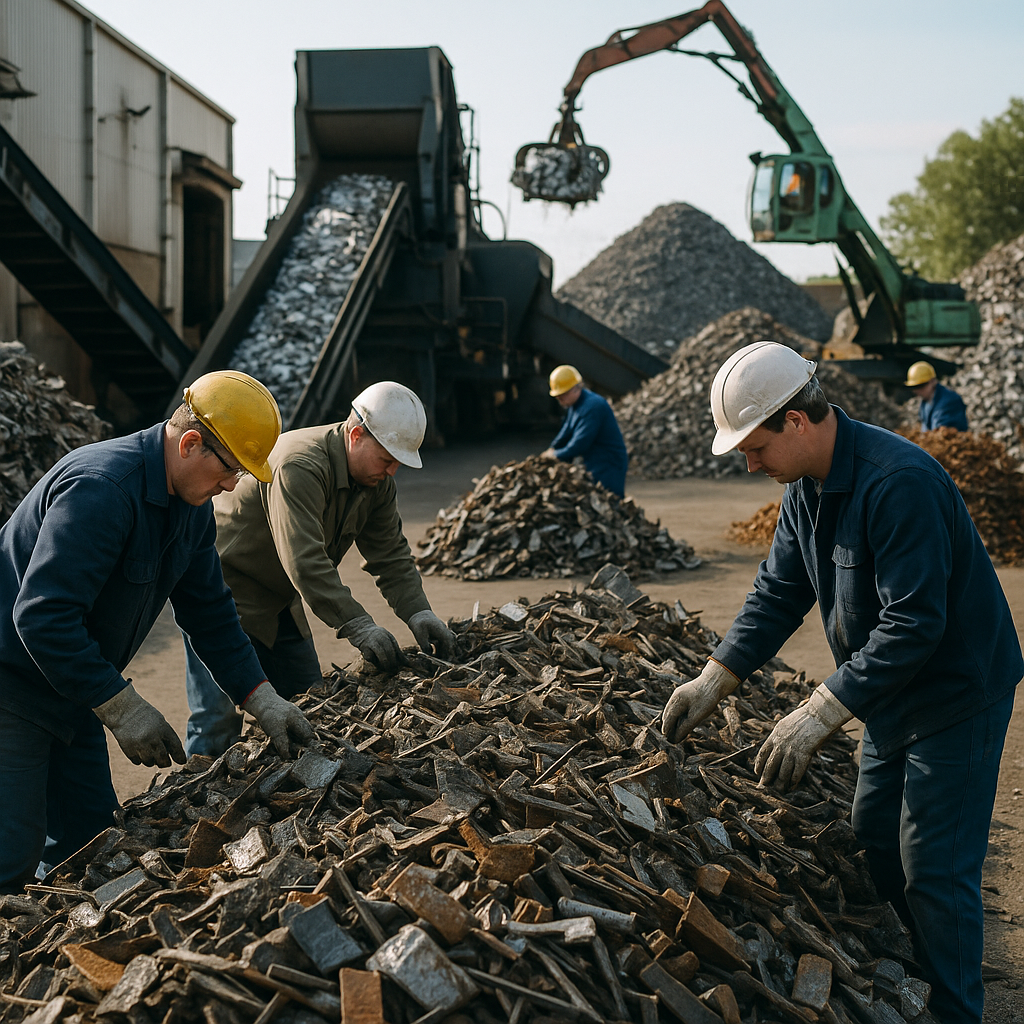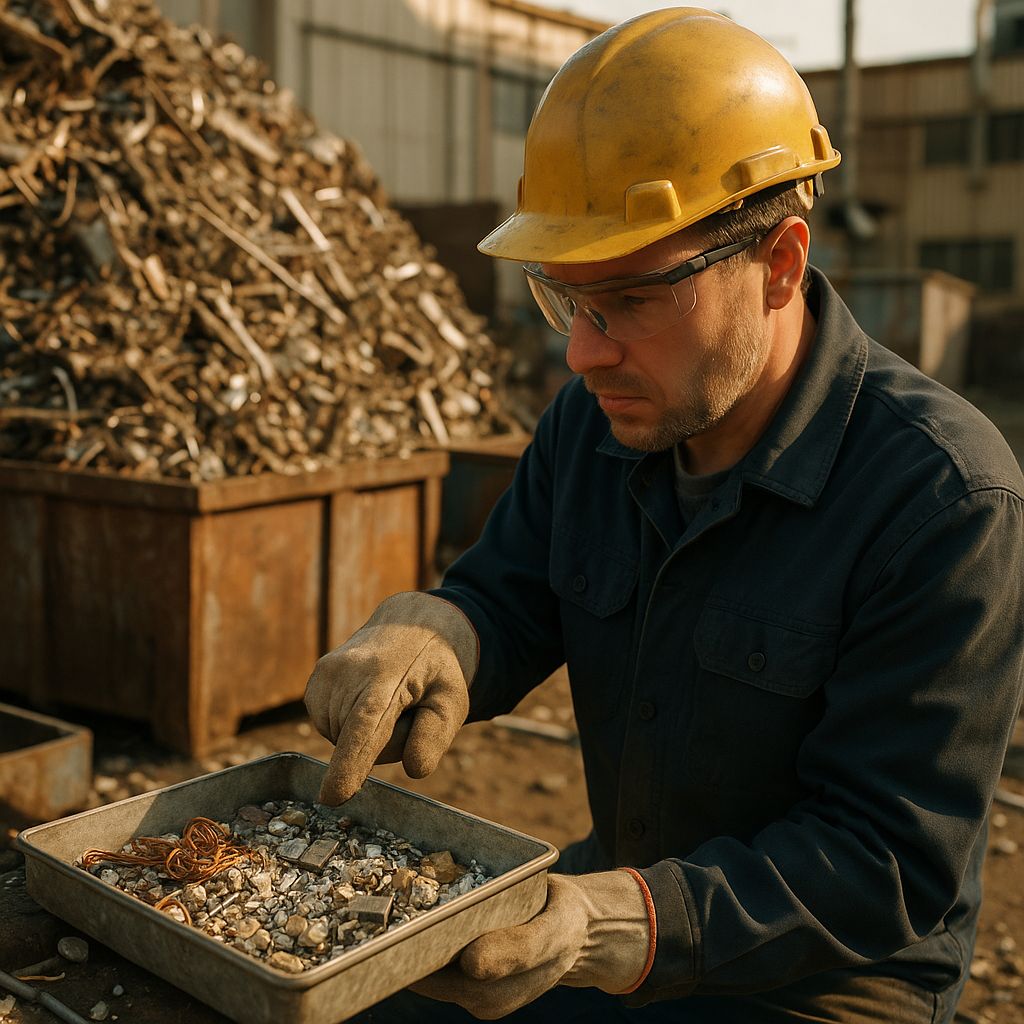5901 Botham Jean Blvd, Dallas, TX 75215
What is Material Flow Analysis in Metal Recycling? A Complete Guide
November 8, 2025Every smartphone, car, and building contains metals that will eventually need recycling. Material flow analysis (MFA) in metal recycling provides a systematic method for tracking these materials throughout their entire journey. This analytical tool creates a visual roadmap of metal movement from initial extraction to final destination.
MFA maps the lifecycle of metals through distinct stages. It begins with metal input from mining operations and follows materials through manufacturing processes where raw metals become products. During the use phase, metals serve their purpose in vehicles and electronics. Finally, MFA tracks the transition to scrap collection, processing, and end-of-life disposal decisions.
This tracking system applies to all metal types. Whether analyzing automotive materials like steel and aluminum or precious metals like gold and silver, MFA highlights inefficiencies and opportunities in the recycling chain. Understanding these material flows allows us to identify metal loss, improve recovery rates, and optimize the recycling process. The National Interdisciplinary Circular Economy Research Programme shows how MFA supports scenario comparisons and guides policy decisions in metal recycling systems.
What Are the Core Stages of a Metal Recycling Flow?

Metal recycling follows a comprehensive flow that transforms end-of-life materials into valuable resources. This process ensures maximum recovery of both ferrous and nonferrous metals while maintaining quality standards for manufacturing purposes.
Primary and Secondary Metal Inputs
The recycling flow begins with two distinct material streams. Primary metal inputs consist of fresh scrap from fabrication and manufacturing, including offcuts, turnings, and rejected components. Secondary metal inputs comprise post-consumer materials that have completed their use phase.
These secondary materials include automotive components, construction debris, household appliances, and electronic waste. Distinguishing between primary and secondary inputs helps optimize sorting and processing protocols for different material conditions and contamination levels.
Collection and Initial Processing
Collection acts as a bridge between end-of-life products and the recycling system. Municipalities, businesses, and individuals contribute materials through curbside programs, drop-off centers, and industrial collection services.
During initial processing, collected materials undergo preliminary sorting to separate metals from non-metallic components. Automated wire cutters remove insulation from electrical components, while magnetic separators distinguish ferrous materials from nonferrous alternatives. This stage sets the foundation for efficient downstream processing.
Advanced Sorting and Material Separation
Advanced sorting employs multiple technologies for precise material categorization. Optical sensors, X-ray fluorescence analyzers, and density separation systems identify specific metal types and grades.
Materials pass through conveyor systems where automated equipment removes contaminants such as plastic, rubber, and other foreign substances. This separation process ensures each metal stream maintains the purity levels needed for effective reprocessing.
Size Reduction and Preparation
Size reduction transforms sorted materials into optimal formats for melting. Hydraulic machinery compacts materials to reduce volume, and industrial shredders break down large components into smaller, uniform pieces.
This preparation stage creates larger surface-to-volume ratios, facilitating more efficient melting processes. The reduced material size also enables better mixing and more consistent chemical composition in the final products.
Melting and Purification
Specialized furnaces melt processed materials at temperatures specific to each metal type. Steel requires different thermal conditions than aluminum or copper, necessitating dedicated equipment for optimal results.
Purification removes remaining impurities through processes such as electrolysis and magnetic separation. These techniques ensure recycled metals meet industry specifications for strength, conductivity, and other critical properties.
Solidification and Product Formation
Purified molten metal undergoes controlled cooling to create standardized forms for manufacturing use. Most facilities produce ingots, bars, or sheets serving as raw materials for various industrial applications.
Chemical additives may be introduced during solidification to achieve specific material properties required by end users. This customization ensures recycled metals can substitute directly for primary materials in manufacturing processes.
Distribution and Reuse Integration
The final stage involves packaging and transporting finished materials to manufacturing facilities. These recycled metals integrate seamlessly into production lines, creating new products that eventually return to the recycling flow.
This circular system demonstrates how effective collection and processing protocols support sustainable manufacturing while reducing dependence on virgin material extraction. The continuous nature of this flow ensures metals maintain their value through multiple use cycles.
How is MFA Used for End-of-Life Vehicles?

Material flow analysis offers a structured method for tracking automotive materials through their entire recycling process. It divides end-of-life vehicle processing into stages: discarding, collection, treatment, resource recovery, and sales/export. Each stage represents a critical point where materials either continue through the recycling chain or exit as waste streams.
The dismantling stage serves as the main collection point for automotive aluminum and other valuable materials. During this phase, operators remove fluids, batteries, tires, and reusable components before separating high-value scrap metals. Research from South Korea’s recycling system shows that dismantling achieves a 62.3% recycling rate, accounting for over 70% of total vehicle recycling efficiency. Valuable scrap metal recovery reaches 36.4% of total vehicle weight, while reusable parts contribute another 19.4%.
Shredding operations follow dismantling and focus on size reduction and magnetic separation of ferrous materials. The process generates automotive shredder residue (ASR), which contains mixed non-ferrous metals, plastics, and other materials. Shredding contributes approximately 23.7% to overall recycling rates, primarily through ferrous metal recovery at 23.5% and nonferrous metal separation at 0.1%.
Heavy recovery processes differentiate between different scrap classifications based on size and surface area ratios. Heavy gauge materials like aluminum wheels and bumpers achieve metal yields of 95% during remelting. Light gauge materials from shredded vehicles typically reach 91% metal recovery rates. This differentiation is crucial for accurate material flow calculations.
Downstream separation systems use advanced sorting technologies to upgrade material quality and specifications. These facilities employ eddy-current separation, density separation, and radiometric sorting to recover specific metal fractions. The separated materials are sent to secondary smelters where final recovery processes convert scrap into recycled products.
MFA quantifies losses at each processing stage to determine overall system efficiency. Material losses occur through mechanisms such as direct landfill disposal of low-value materials, oxidation losses during thermal processing, and contamination that renders materials unrecyclable. Studies of Korean end-of-life vehicle systems show how systematic tracking reveals improvement opportunities in waste refrigerant recovery and plastic material recycling.
The analysis indicates that automotive aluminum recycling achieves approximately 91% efficiency in integrated systems. Collection rates reach 99.7% through dismantling and downstream separation. Recovery process limitations account for most material losses, particularly in light gauge scrap processing where high surface area increases oxidation rates.
Waste percentage calculations rely on accurate material flow measurements at system boundaries. MFA practitioners track both mass flows and composition changes as materials progress through processing stages. This method allows recycling facilities to identify bottlenecks and optimize resource recovery from automotive waste streams.
How Does MFA Help Manage Material Losses?

Material flow analysis serves as a diagnostic tool for recycling operations by systematically tracking where materials are lost throughout processing stages. This approach maps every step from initial input materials through quality control checkpoints to final product formation, revealing specific points where valuable materials exit the system as waste instead of continuing through the recycling chain.
Quality control stages are critical intervention points where MFA identifies the highest material losses. During the processing of mixed waste streams, sorting technologies and screening processes often reject materials that fail to meet specifications. MFA quantifies these rejection rates and highlights which quality standards contribute most significantly to material losses. Operators can then adjust processing parameters or invest in upgraded sorting equipment to recover more materials that would otherwise be discarded.
The visual nature of MFA diagrams makes inefficiencies immediately apparent to facility managers. Material flow analysis provides clear pathways showing how input materials transform through each processing stage. When diagrams reveal substantial losses at specific points, operators can target improvement efforts on those bottlenecks. This focused approach generates faster returns on process optimization investments compared to broad facility upgrades.
With MFA, process improvement becomes data-driven, offering quantitative measures of recycling efficiency. The analysis shows which processing stages achieve the best material recovery rates and which need attention. Facilities can benchmark their performance against theoretical maximum recovery rates for different material types, guiding decisions about equipment upgrades, process modifications, and staff training priorities.
Optimization of waste management naturally follows from understanding material loss patterns identified through MFA. The analysis distinguishes between unavoidable losses inherent to processing technologies and preventable losses due to operational issues. Facilities can implement targeted waste reduction strategies for preventable losses while exploring alternative processing methods for materials with consistently high loss rates. This systematic approach to loss management maximizes the value extracted from incoming waste streams and ensures compliance with sustainability requirements.
Conclusion: Optimizing Recycling with Material Flow Analysis

Material flow analysis is a transformative approach to optimizing recycling operations in the metal recovery industry. By systematically tracking materials from initial input through vehicle dismantling, processing, and end-of-life management, MFA provides the comprehensive data needed to enhance recycling efficiency and reduce material losses. This methodology enables recycling facilities to identify bottlenecks, quantify waste streams, and implement targeted improvements that boost recovery rates while supporting the circular economy. The insights gained from mapping material lifecycle patterns help create more sustainable systems that maximize resource utilization and minimize environmental impact.
As the recycling industry evolves toward greater sustainability and resource management excellence, MFA will become increasingly critical for organizations seeking competitive advantages and regulatory compliance. For municipalities and businesses aiming to optimize metal recycling operations and implement data-driven waste management strategies, professional expertise is crucial. Contact Okon Recycling at 214-717-4083 to discuss how our advanced recycling solutions can help you achieve your sustainability goals.
